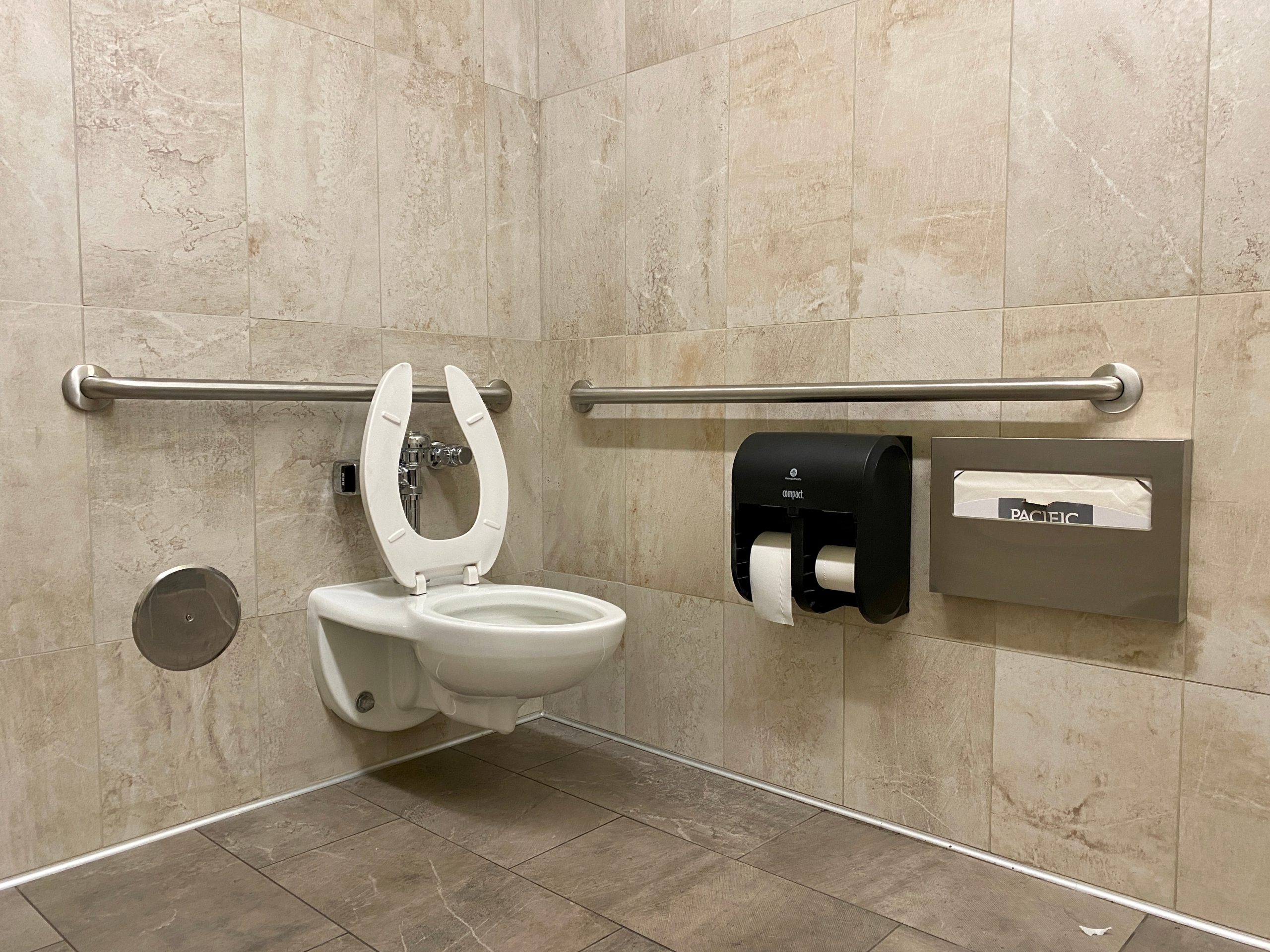ADA Single Bathroom Layout Design for Today and The Future

The Americans with Disabilities Act (ADA) isn’t just a law for your ADA single bathroom layout plans; it’s a promise of dignity and inclusivity. When it comes to public restrooms, ADA compliance is not about checking boxes. It’s about creating spaces where everyone feels comfortable and respected.
A visit to the restroom shouldn’t be an afterthought, but instead, a seamless experience for everyone. ADA-compliant bathrooms are more than just accessible. From spacious layouts that allow for effortless maneuvering to grab-bars strategically placed for support, these are thoughtfully designed to accommodate diverse needs, where every detail matters.
When businesses prioritize ADA compliance, they’re doing more than following regulations. They are making a statement about their values. An accessible bathroom is about convenience, a symbol of respect for all patrons that sends a welcoming message regardless of their abilities.
Consider someone who is a wheelchair user and loves exploring new restaurants. In the past, restroom visits were often a source of anxiety. Think of the military veteran with mobility challenges who can now attend family basketball games at a son or daughter’s school without the stress of navigating cramped restrooms.
Thanks to ADA-compliant designs, these individuals can enjoy meals, public events, and navigating other venues without worrying about accessibility. It’s a whole new way of thinking that continues transforming the lives of your visitors, guests, clients, customers, and even employees.
The Business Case for ADA Single Bathroom Layout
Beyond the moral and compliance imperatives, there’s a compelling business case for integrating ADA single bathroom layout solutions into your organization’s growth mindset. When businesses create inclusive spaces, they tap into a wider customer base. People with disabilities and their families are more likely to patronize establishments that value their needs.
Moreover, ADA-compliant designs often benefit everyone, not just those with disabilities. A spacious layout is appreciated by parents with strollers, and grab-bars can provide extra support for older adults. Your company or organization can design for the future, not yesterday.
As our population ages and the need for accessible spaces grows, ADA compliance becomes even more critical. The number of Americans ages 65 and older will more than double over the next 40 years, reaching 80 million in 2040 according to Urban Institute. “The number of adults ages 85 and older, the group most often needing help with basic personal care, will nearly quadruple between 2000 and 2040,” it states.
By investing in universal, diverse designs today, businesses are not only meeting current needs but also future-proofing their facilities. They’re creating a legacy of accessibility that benefits everyone.
Reimagining public restrooms as more than just functional spaces begins with simple steps. It starts by designing them with dignity in mind, ensuring everyone can access them with ease and comfort. ADA compliance is an opportunity and much more than just a legal requirement.
However, understanding ADA restroom floor plans comes with commercial intricacies. When it comes to designing spaces where anyone can feel comfortable, the minutiae of ADA commercial bathroom floor plans often pose the biggest hurdles. In this regard, accessibility and compliance is of paramount importance.
Commercial Spaces and the Importance of ADA Compliance
Ever since its signing in 1990, the Americans with Disabilities Act has set the precedent for simple comforts that many take for granted today when they consider ADA single bathroom layout options. Up until this point, many of today’s public restroom conveniences were often overlooked. Accessibility wasn’t the facility owner or manager’s responsibility.
Not anymore. ADA restroom floor plans in commercial areas can make a big difference. This is huge, since a growing part of the nation’s aging population suffers from a disability.
According to the U.S. Census Bureau, the total U.S. civilian non-institutionalized population with a disability in 2021 was 42.5 million, or 13 percent of the population. Additionally, the total population from ages 18-to-64 with a disability who were employed was 8.7 million individuals. “The percentage of West Virginia’s civilian non-institutionalized population with a disability in 2021 was 18.7 percent, among the highest in the nation, while Utah, at 10.3 percent, had one of the lowest rates of disability.”
Additionally, the U.S. Justice Department’s Civil Rights Division forecasts a substantial future need for ADA compliance. This not only goes for the 50 million Americans currently living with some kind of disability, but also for the 71.5 million baby boomers that will soon require some sort of service.
The research and compliance legalities of ADA can feel mind-boggling. However, the ADA design experts have narrowed it down. In general, the ADA is a federal law mandating accessibility for individuals with disabilities in public places, including commercial properties and commercial bathroom floor plans.
Non-compliance can result in costly legal issues and fines. By designing ADA-compliant bathroom floor plans, you reduce the risk of legal complications. Fortunately, ADA guidelines give you a good framework and parameters to work in.
Expanding Your Customer Base with ADA Single Bathroom Layout
An ADA single bathroom layout demonstrates your commitment to the public and can expand your customer base to include individuals with disabilities. It also helps build a positive reputation as an accommodating business, which can lead to increased patronage and customer loyalty.
All the little details that go into an ADA bathroom floor plan can be narrowed down into a few key categories. Identifying these early and allowing them to guide your design process will make the design work easier in the long run. Consider size and space, as well as fixtures and accessories.
You should get into a mindset of minimums and maneuverability:
- Minimum dimensions: ADA regulations specify minimum dimensions for bathroom stalls, clear floor space, and fixtures to accommodate individuals with disabilities.
- Maneuverability: Sufficient space ensures easy maneuverability for wheelchair users and those with mobility challenges.
An effective commercial bathroom must also be comfortable for all types of patrons, including:
- Fixtures and accessories. From grab-bars to sinks, toilets, and paper towel dispensers, the appropriate heights for wheelchair users are important considerations. These details are also key for non-wheelchair users.
- Accessories. ADA-compliant fixtures include a multitude of appropriate-height level options.
Above all, one of the most important aspects is to make sure there’s clear floor space under fixtures for wheelchair users to approach comfortably.
How Tailored Designs Fit Into ADA Planning
Tailoring ADA single bathroom layout designs to your company’s needs will put you ahead of the competition. Professional manufacturers and designers can create customized bathroom floor plans that suit your specific commercial space, optimizing layout and functionality. They ensure efficient use of space, maximizing accessibility while maintaining an aesthetically pleasing design.
You can also avoid costly mistakes. Federal law allows for $75,000 in damages for the first violation and up to $150,000 for subsequent violations. As for who can sue, the answer is anyone who feels they’ve been discriminated against.
So, it stands to reason to avoid these penalties. The goal is to prevent any legal issues and guarantee long-term savings. Professional designers can help you avoid costly legal problems due to non-compliance, saving you time and money.
Finding a provider that can design, engineer, and manufacture fixtures and appliances is crucial. They’ll quickly become a non-negotiable part of your team and ensure your success with future ADA bathroom floor plans in commercial projects. A partner that can deliver custom solutions and avoid expensive mistakes while tailoring your right-sized design is key.
Investing in professional design also prevents expensive retrofits later, elevating the longevity of your bathroom facilities.
Remember that the ADA was established to provide all persons with disabilities the same opportunities and rights as everybody else. There are specific dimensions and requirements that should be followed. These requirements and guidelines were established to ensure individuals with disabilities have appropriate and accessible spaces.
They are not optional. Every restroom and bathroom at parks, offices, commercial properties, construction sites, recreational centers, and other buildings and facilities should strictly adhere to them to avoid lawsuits and civil penalties.
American Specialties, Inc.
American Specialties, Inc. (ASI) develops your ADA single bathroom layout by taking functionality and user experience to the next level. For customers who demand innovative products, ASI offers a complete collection of commercial and office washroom equipment.
Additionally, ASI Group designs, engineers, and manufactures from a single source. This includes fully integrated washroom accessories, partitions, lockers, and visual display products. It’s just the beginning of what ASI has to offer.
By incorporating must-have accessories, you can create a commercial restroom that is both stylish and functional.

